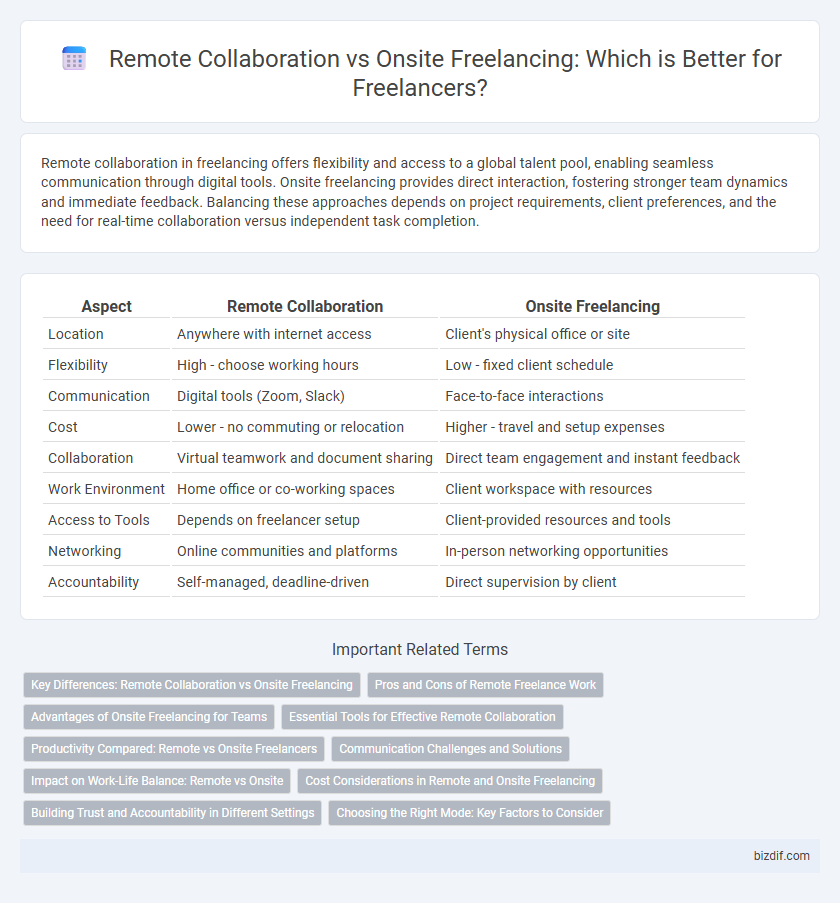Remote collaboration in freelancing offers flexibility and access to a global talent pool, enabling seamless communication through digital tools. Onsite freelancing provides direct interaction, fostering stronger team dynamics and immediate feedback. Balancing these approaches depends on project requirements, client preferences, and the need for real-time collaboration versus independent task completion.
Table of Comparison
| Aspect | Remote Collaboration | Onsite Freelancing |
|---|---|---|
| Location | Anywhere with internet access | Client's physical office or site |
| Flexibility | High - choose working hours | Low - fixed client schedule |
| Communication | Digital tools (Zoom, Slack) | Face-to-face interactions |
| Cost | Lower - no commuting or relocation | Higher - travel and setup expenses |
| Collaboration | Virtual teamwork and document sharing | Direct team engagement and instant feedback |
| Work Environment | Home office or co-working spaces | Client workspace with resources |
| Access to Tools | Depends on freelancer setup | Client-provided resources and tools |
| Networking | Online communities and platforms | In-person networking opportunities |
| Accountability | Self-managed, deadline-driven | Direct supervision by client |
Key Differences: Remote Collaboration vs Onsite Freelancing
Remote collaboration allows freelancers to work from any location using digital tools like Zoom, Slack, and Trello, increasing flexibility and access to global clients. Onsite freelancing requires physical presence at the client's office, fostering direct interpersonal communication and immediate feedback but limiting work location freedom. Productivity in remote collaboration depends heavily on strong self-discipline and reliable internet connectivity, while onsite freelancing benefits from structured environments and face-to-face mentorship opportunities.
Pros and Cons of Remote Freelance Work
Remote freelance work offers flexibility in schedule and location, enabling access to global clients and reducing commuting costs, which enhances productivity and work-life balance. However, it can lead to challenges such as communication barriers, feelings of isolation, and difficulties in maintaining team cohesion compared to onsite freelancing. The reliance on digital tools requires strong self-discipline and effective time management to meet project deadlines efficiently.
Advantages of Onsite Freelancing for Teams
Onsite freelancing offers direct, real-time communication that enhances team collaboration and reduces misunderstandings during project development. Being physically present fosters stronger relationships and trust among team members, driving higher accountability and productivity. Immediate access to shared resources and quick problem-solving opportunities further streamline workflows and ensure project milestones are met efficiently.
Essential Tools for Effective Remote Collaboration
Essential tools for effective remote collaboration include project management software like Trello or Asana, which streamline task organization and team communication. Video conferencing platforms such as Zoom or Microsoft Teams enable real-time interaction, fostering clearer understanding and stronger connections among remote freelancers and clients. Cloud-based file sharing services like Google Drive or Dropbox ensure seamless access to documents, promoting efficient workflow and reducing delays in project execution.
Productivity Compared: Remote vs Onsite Freelancers
Remote freelancers often demonstrate higher productivity due to flexible work environments and reduced commuting time, allowing focused task completion. Onsite freelancers benefit from immediate team interaction and structured schedules, which can enhance real-time problem solving and accountability. Studies show remote workers can deliver up to 13% more output, though the effectiveness depends on communication tools and individual discipline.
Communication Challenges and Solutions
Remote collaboration in freelancing often encounters communication challenges such as time zone differences, lack of face-to-face interaction, and potential misinterpretation of messages due to reliance on digital channels. Solutions include using synchronized communication tools like Slack or Zoom, setting clear deadlines, and establishing regular check-ins to maintain transparency and alignment. Onsite freelancing typically benefits from immediate feedback and non-verbal cues, reducing misunderstandings and fostering quicker decision-making.
Impact on Work-Life Balance: Remote vs Onsite
Remote freelancing significantly enhances work-life balance by eliminating commute times and offering flexible scheduling, allowing freelancers to tailor their work environment and hours to personal needs. Onsite freelancing often demands fixed hours and physical presence, which can limit personal time and increase stress levels due to rigid routines and commuting challenges. Studies show freelancers working remotely report higher satisfaction and reduced burnout rates compared to their onsite counterparts, emphasizing remote work's positive impact on overall well-being.
Cost Considerations in Remote and Onsite Freelancing
Remote freelancing significantly reduces overhead costs such as office space, utilities, and commuting expenses, resulting in higher net income for freelancers and cost savings for clients. Onsite freelancing often involves travel, accommodation, and meal expenses that increase the overall project budget, particularly for long-term engagements. Evaluating these cost considerations is essential for businesses when deciding between remote collaboration or onsite freelancing to optimize financial efficiency.
Building Trust and Accountability in Different Settings
Building trust in remote freelancing relies heavily on consistent communication, clear deliverables, and the use of project management tools like Trello or Asana to track progress. Onsite freelancing fosters accountability through face-to-face interactions and immediate feedback, which naturally strengthen professional relationships. Both settings benefit from regular check-ins and transparent workflows to ensure mutual reliability and project success.
Choosing the Right Mode: Key Factors to Consider
Evaluating remote collaboration versus onsite freelancing involves assessing communication efficiency, project complexity, and team dynamics. Remote collaboration leverages digital tools for flexibility and access to global talent, enhancing productivity for tech-driven tasks. Onsite freelancing fosters direct interaction and immediate feedback, crucial for projects requiring hands-on involvement or sensitive information handling.
remote collaboration vs onsite freelancing Infographic

 bizdif.com
bizdif.com